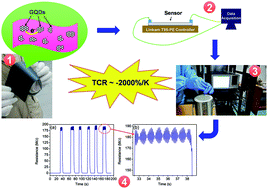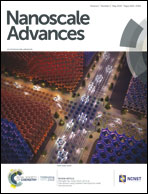An ultrafast quantum thermometer from graphene quantum dots
Abstract
We report an ultra-sensitive temperature sensor derived from graphene quantum dots (GQDs) embedded in a self-standing reduced graphene oxide (RGO) film. The GQDs are obtained as a natural derivative during synthesis of GO to RGO. A fundamental study on low temperature transport mechanisms reveals the applicability of temperature zone specific ‘variable range hopping (VRH)’ conduction models, i.e. Mott-VRH, Efros–Shklovskii-VRH and activation energy supported VRH. On the basis of transport behavior and confirmed by characterization analyses, the RGO film is modeled as GQD arrays where graphitic (sp2) domains behave as QDs and oxygenated (sp3) domains between interdots act as tunneling barriers. Temperature dependent resistance and current–voltage (I–V) characteristics indicate high sensitivity where sensor resistance changes by almost six orders of magnitude as the temperature is varied between 300 and 12 K. In convection mode, the developed temperature sensor shows a temperature coefficient of resistance (TCR) of ∼−1999% K−1 in the 300–77 K temperature range, which is much higher than the TCR values reported so far. Additionally, the sensor exhibits an extremely fast response (∼0.3 s) and recovery (0.8 s) time; and such high TCR leads to ultra high resolution of ∼ μK. The sensor shows excellent repeatability with negligible drift over several cycles. These studies are crucial for modern day thermal management and sensitive cryogenic applications.

- This article is part of the themed collections: Quantum and carbon dots and International Year of the Periodic Table : Low Dimensional Carbon Systems


 Please wait while we load your content...
Please wait while we load your content...